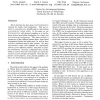Free Online Productivity Tools
i2Speak
i2Symbol
i2OCR
iTex2Img
iWeb2Print
iWeb2Shot
i2Type
iPdf2Split
iPdf2Merge
i2Bopomofo
i2Arabic
i2Style
i2Image
i2PDF
iLatex2Rtf
Sci2ools
104
click to vote
ICRA
2000
IEEE
2000
IEEE
Feature Based Condensation for Mobile Robot Localization
Much attention has been given to CONDENSATION methods for mobile robot localization. This has resulted in somewhat of a breakthrough in representing uncertainty for mobile robots. In this paper we use CONDENSATION with planned sampling as a tool for doing feature based global localization in a large and semi-structured environment. This paper presents a comparison of four different feature types: sonar based triangulation points and point pairs, as well as lines and doors extracted using a laser scanner. We show experimental results that highlight the information content of the different features, and point to fruitful combinations. Accuracy, computation time and the ability to narrow down the search space are among the measures used to compare the features. From the comparison of the features, some general guidelines are drawn for determining good feature types.
Related Content
| Added | 25 Aug 2010 |
| Updated | 25 Aug 2010 |
| Type | Conference |
| Year | 2000 |
| Where | ICRA |
| Authors | Patric Jensfelt, David J. Austin, Olle Wijk, Magnus Andersson |
Comments (0)

